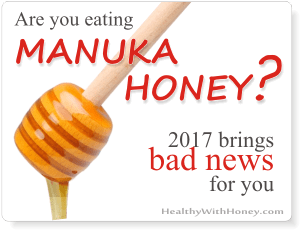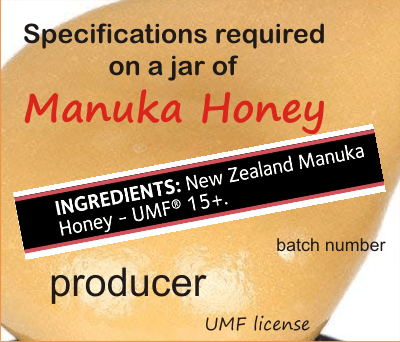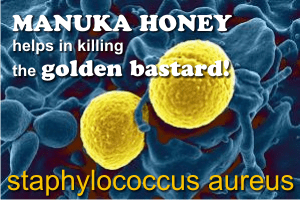Manuka honey is one of the most researched honeys in the world. It has different markers and grades, all at expensive prices. And lots and lots of fraud.
Due to different policies, genuine producers have graded manuka honey using different letters and numbers.
I have already covered them in the article I want to buy manuka honey. What is UMF 16+, MGO 400+, Active?
Here are some updates and clarifications:
A (Active) or TA (Total Activity) or BioActive
A or TA or BioActive based brands measure the hydrogen peroxide activity.
The associated numbers refer to naturally occurring peroxide activity levels, which are levels found in all types of honey (whether manuka, acacia, clover etc). They are also known to be unstable (decrease) with time, heat and light. A ‘TA’ honey cannot be compared to a genuine UMF® certified jar.
It is simply a way of somehow grading the honey, to make it more valuable in consumers’ eyes.
They are usually much cheaper.
ACTIVE is more used in USA and Canada. Food and Drug Administration or the Canadian Food Inspection Agency, do not support the medical claims covered by the Unique Manuka Factor Association in New Zealand, and do not approve using their grades. The producers that use ACTIVE grade, followed by a number, also take into consideration some other factors that define a honey’s quality: live enzymes, pollen count, chemical/residue analysis, antioxidant levels, the raw status or unpasteurization process, and various other phytochemical factors found in Manuka honey. In North America, Wedderspoon is considered a very good and reliable manuka honey producer.
MGO™ (methylglyoxal)
– A trademark of Manuka Health New Zealand, referring strictly to the amount of MGO (aka MG) found in it. Scientific evidence has confirmed methylglyoxal as one of the key compounds naturally occurring in New Zealand manuka honey. 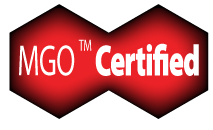 Some scientists considered MGO the main factor of all the antibacterial properties of honey. In 2016, Manuka Health celebrated 10 years since Thomas Henle and his team discovered the huge amounts of MGO in manuka honey and attributed its antibacterial properties to it. Compared to other honeys, which can contain MGO from 0 to 5 mg/kg, manuka honey has 100 to even 800 mg/kg.
Some scientists considered MGO the main factor of all the antibacterial properties of honey. In 2016, Manuka Health celebrated 10 years since Thomas Henle and his team discovered the huge amounts of MGO in manuka honey and attributed its antibacterial properties to it. Compared to other honeys, which can contain MGO from 0 to 5 mg/kg, manuka honey has 100 to even 800 mg/kg.
(more here: The celebration of manuka honey. Is MGO700 better than MGO300? Is manuka honey toxic?)
– It’s a quality system introduced in 2007
– It ranges from MGO™30 to MGO™550 (30mg/kg to 550mg/kg)
MGO™30 (containing 30mg/kg) – table grade
MGO™100 (containing 100mg/kg) – table grade
MGO™250 (containing 250mg/kg) – table grade
MGO™400 (containing 400mg/kg) – antibacterial grade, suited for skin therapy.
MGO™550 (containing 550mg/kg) – high antibacterial grade, suited for skin therapy.
! What you buy is not necessary what you have.
Not because of the producers, who are very strict and trustful, but because MGO quantity changes in time. What is written on the label is the amount of MGO found in honey at the time of testing and packing. According to Analytica Laboratories the content of MGO (MG) changes a lot in time, going from an initial 196 mg/kg to even 765 mg/kg after 8 months of storage at 27ºC.
Why does the MGO content increase? Because another component of manuka honey, DHA turns to MGO in time. Below there is a forecast of a sample of manuka honey, tested by Analytica Laboratories. MG stands for methylglyoxal, NPA stands for non-peroxide activity, HMF is Hydroxymethylfurfural, which is produced from the breakdown of sugar and is used as an indicator of heat treatment and aging. Read more about all these indicators here.

KFACTOR™ (Key factors)
It’s a trademark of the Wedderspoon company. They have created KFactor™, a holistic multi-stage authentication system named for the key factors inherent in manuka honey, defining properties used to authenticate manuka honey.
This grade DOES NOT stand for its therapeutic value, but for its authenticity as genuine monofloral manuka honey.
KFactor12 – guarantees that there are 65% manuka pollen grains in all the pollen grains from the honey:
KFactor16 – guarantees that there are 75% manuka pollen grains in all the pollen grains from the honey:
KFactor22 – guarantees that there are 90% manuka pollen grains in all the pollen grains from the honey.
Wedderspoon is funding research using Nuclear Magnetic Resonance (NMR) imaging. This highly sensitive technology will not only measure known components, but also seek to identify additional components present only in Manuka honey. It is the synergy of live enzymes, high pollen count, DHA, methylglyoxal, and other key factors, they hope to identify by the unique NMR technology.
 UMF™ (Unique Manuka Factor)
UMF™ (Unique Manuka Factor)
– A trademark in New Zealand, which insures purity and quality.
– It’s a grading system that measures three unique signature compounds: Leptosperin, DHA, MGO (which are all important key markers)
– It is the only international quality standard, with multiple laboratories around the world able to verify test results. It also offers an independent, internationally recognised verification program. The UK’s own Food and Environmental Research Agency (FERA) can verify UMF® labels.
– The numbers that follow UMF refer to the percentage of phenol in water. For example, UMF12 equals a 12% solution of phenol in water.
– The numbers range from 10 to 25 (for therapeutic value) The higher the rating, the more potent the honey.
UMF 5+ → shows lower levels of antibacterial activity, yet this manuka honey makes an excellent nutritional supplement.
UMF10+ → Low to medium level antibacterial activity, suitable for helping to maintain good health.
UMF15+ → High antibacterial activity
UMF20+ → Very high antibacterial properties.
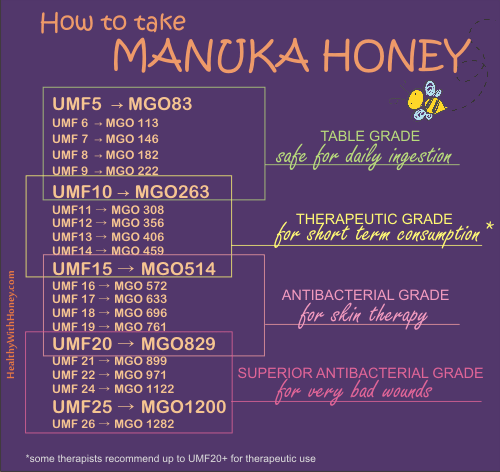
The UMF® mark is a registered trademark, invented to grade the honey but also to protect the consumer that is getting a manuka honey that does actually contain the healing properties it is famous for.
Here is a list of all UMF licensed brands.
Other simple numbers:
Other manuka honey jars display only numbers on their front label. No other letter. Practically, they do not represent anything, we don’t know if that honey comes from manuka or not, it has no mark of any trustworthy test done. Do not buy them.
How should we check a jar of manuka honey to see if it’s genuine?
1. If you want to be 100% sure you purchased genuine UMF® Manuka Honey, check the label for all following specifications:
– UMF® trademark on the front label (ranging from UMF5+ to UMF20+)
– New Zealand producer’s name
– producer’s UMFHA license number
– batch number
– UMFHA also recommends that manuka honey should be packed into jars and labelled in New Zealand.
Manuka honey should also be packed in New Zealand. And it should be written on the label as well!
In February 2017, the Queen’s official grocer, pulled manuka honey from UK shelves.
Why? He was concerned that some pots might not contain what the label claimed. The Sunday Times revealed three British stores were selling honey that failed basic manuka standards.
Manuka honey should be packed in New Zealand. When manuka is exported overseas in bulk, it can be diluted with other, cheaper honeys. Why? Well, that’s simple: to maximise profits.
Other companies based in New Zealand also produce genuine manuka honey, though they are not members of the UMFHA.
2. Wedderspoon guarantees genuine manuka honey, though this doesn’t say much about its antibacterial properties.
3. Manuka Health offers genuine manuka honey, we can easily recognize it from the MGO™ marker on the label.
Case study:
Haddrells of Cambridge, http://haddrells.co.nz/, a private company, wholly owned by Richard and Moira Haddrell. Based in Cambridge, New Zealand, produce and export honey, bee pollen and propolis. It is UMFHA licensed no. 1027
Their distributors:
– Lifeplan Products Limited in the UK → ‘GOLDENHILLS MANUKA HONEY’ (http://www.haddrells.co.nz/product-goldenhills.html)
– Jna-net Japan in Japan
– Back to nature in Hong Kong → ‘Manuka honey’ (http://www.manukahoney.hk/)
– Thoroughbred Remedies Ireland Ltd in Ireland → ‘Manuka honey'(https://www.triequestrian.ie/)
– Natures Farm in Singapore/ Malaysia → ‘Haddrell’s of Cambridge Manuka Honey’ (http://www.naturesfarm.com/)
– Costco Wholesale Korea Ltd in Korea
Frauds?
Here comes the case of Trader Joe’s. The jar has no clear pictures, no producer mentioned, no batch number, only a license number, which is 1027, belonging to Haddrells of Cambridge.
The name of the distributor cannot be found among the other distributors listed on the producer’s page, and neither is the number of this product.
Now, would you buy this manuka honey?
On Amazon we can find jars of manuka honey made by Haddrells, sold by all these distributors. BUT, the jars don’t have clear pictures from all sides, their labels don’t specify where was the honey bottled, which is the batch number and the UMF license number.
In this point, we can immediately assume that the sellers have made similar jars, similar labels and filled them with something else. Since we lack all this information, I do not recommend buying this honey, though the producers may be fair and correct.
Frauds
• In 2012 UMFHA tested 73 samples from Britain, China and Singapore. 41 of them had no non-peroxide activity. Other tests made in Hong Kong found that of 55 manuka honey samples, 14 had been adulterated with syrup.
• On 25 August 2013 the Sunday Times reported examples of 3 products sold in the UK, that had a number on the jar, but no measure of the special non-peroxide or UMF activity was given. Preliminary scientific tests showed ‘undetectable’ levels.
From the brands tested:
x Pure Gold (different grades) → no NPA detected (was it manuka honey?)
x Manuka Doctor (different grades)→ no NPA (non-peroxide activity) detected
√ Comvita 10+ → NPA 19
√ Rowse 10+ → NPA 11
In 2013 statistics showed that:
– the typical annual New Zealand harvest is of 1,700 tons of manuka honey
– the annual consumption in the UK is of 1,800 tons of manuka honey
– the global consumption is estimated at 10,000 tons of manuka honey! How about that!
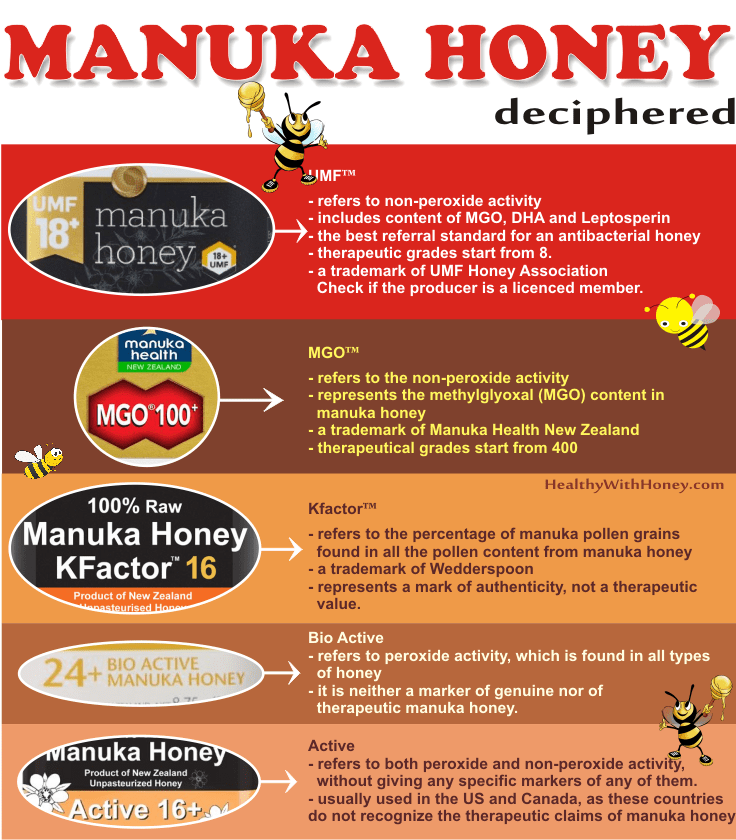
**********************************
References:
http://www.newzealandhoneyshop.co.uk/blog/manuka-honey-sunday-times.html
http://www.stuff.co.nz/business/industries/73006740/Detector-to-identify-fake-Manuka-honey-launched
wedderspoon.com/manuka-honey-science/kfactor
http://www.stuff.co.nz/business/industries/73006740/Detector-to-identify-fake-Manuka-honey-launched
http://www.newshub.co.nz/home/money/2017/02/kiwi-manuka-honey-pulled-from-uk-shelves.html

